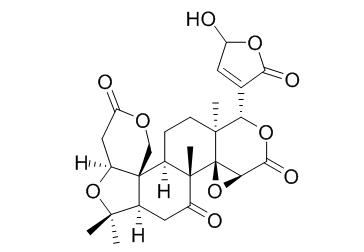Isolimonexic acid
Isolimonexic acid exhibits cytotoxicity on MCF-7 cell lines, it also inhibits Panc-28 cancer cell growth.
Inquire / Order:
manager@chemfaces.com
Technical Inquiries:
service@chemfaces.com
Tel:
+86-27-84237783
Fax:
+86-27-84254680
Address:
1 Building, No. 83, CheCheng Rd., Wuhan Economic and Technological Development Zone, Wuhan, Hubei 430056, PRC
Providing storage is as stated on the product vial and the vial is kept tightly sealed, the product can be stored for up to
24 months(2-8C).
Wherever possible, you should prepare and use solutions on the same day. However, if you need to make up stock solutions in advance, we recommend that you store the solution as aliquots in tightly sealed vials at -20C. Generally, these will be useable for up to two weeks. Before use, and prior to opening the vial we recommend that you allow your product to equilibrate to room temperature for at least 1 hour.
Need more advice on solubility, usage and handling? Please email to: service@chemfaces.com
The packaging of the product may have turned upside down during transportation, resulting in the natural compounds adhering to the neck or cap of the vial. take the vial out of its packaging and gently shake to let the compounds fall to the bottom of the vial. for liquid products, centrifuge at 200-500 RPM to gather the liquid at the bottom of the vial. try to avoid loss or contamination during handling.
Int J Food Sci Nutr.2019, 70(7):825-833
J Physiol Biochem.2024, 80(2):421-437.
Biochem Biophys Res Commun.2018, 505(1):261-266
Sci Rep.2021, 11(1):21038.
J Ethnopharmacol.2016, 192:370-381
Nat Chem Biol.2018, 14(8):760-763
Foods.2021, 10(11):2627.
Mol Pharm.2018, 15(8):3285-3296
Integr Med Res.2017, 6(4):395-403
Agronomy2020, 10(10),1489
Related and Featured Products
Food Funct. 2013 Feb;4(2):258-65.
Limonoids and their anti-proliferative and anti-aromatase properties in human breast cancer cells.[Pubmed:
23117440 ]
METHODS AND RESULTS:
The compounds were identified by TLC, HPLC, and LC-MS techniques. A panel of 9 purified limonoids, including limonin, nomilin, obacunone, limonexic acid (LNA), Isolimonexic acid (ILNA), nomilinic acid glucoside (NAG), deacetyl nomilinic acid glucoside (DNAG), limonin glucoside (LG) and obacunone glucoside (OG) as well as 4 modified compounds such as limonin methoxime (LM), limonin oxime (LO), defuran limonin (DL), and defuran nomilin (DN), were screened for their cytotoxicity on estrogen receptor (ER)-positive (MCF-7) or ER-negative (MDA-MB-231) human breast cancer cells. We further tested the mechanism of the anti-proliferative activity of limonoids using an in vitro aromatase enzyme assay and western blot with anti-caspase-7. Among the tested limonoids, 11 limonoids exhibited cytotoxicity on MCF-7 whereas 8 limonoids showed cytotoxicity against the MDA-MB-231 cell lines. Although most of the limonoids showed anti-aromatase activity, the inhibition of proliferation was not related to the anti-aromatase activity. On the other hand, the anti-proliferative activity was significantly correlated with caspase-7 activation by limonoids.
CONCLUSIONS:
Our findings indicated that the citrus limonoids may have potential for the prevention of estrogen-responsive breast cancer (MCF-7) via caspase-7 dependent pathways.
J Agric Food Chem. 2009 Nov 25;57(22):10933-42.
Bioactive compounds from Mexican lime ( Citrus aurantifolia ) juice induce apoptosis in human pancreatic cells.[Pubmed:
19919125]
Lime (Citrus aurantifolia Swingle) is one of the major citrus fruits and widely consumed, but there is limited evidence about its health-promoting properties.
METHODS AND RESULTS:
Hence, an investigation was conducted to understand the chemopreventive effects of lime juice on pancreatic cancer cells and the possible mechanism for induction of apoptosis using Panc-28 cells. Freeze-dried lime juice was extracted with different solvents, such as chloroform, acetone, MeOH, and MeOH/water (8:2). The chloroform extract showed the highest (85.4 and 90%) radical-scavenging activity by 1,1-diphenyl-2-picryl hydrazyl (DPPH) and 2,2'-azino-bis(3-ethylbenzthiazoline-6-sulfonic acid) (ABTS) methods at 624 microg/mL, whereas the MeOH/water extract showed the lowest (<20%) activity. The active components were identified by high-performance liquid chromatography (HPLC) using a C-18 column as rutin, neohesperidin, hesperidin, and hesperitin. Furthermore, the limonoids identified are limonexic acid, Isolimonexic acid, and limonin. All of the extracts of lime juice inhibited Panc-28 cancer cell growth. The MeOH extract exhibited the maximum activity, with an IC50 value of 81.20 microg/mL after 72 h. The inhibition of Panc-28 cells was in the range of 73-89%, at 100 microg/mL at 96 h. The involvement of apoptosis in induction of cytotoxicity was confirmed by expression of Bax, Bcl-2, casapase-3, and p53.
CONCLUSIONS:
The results of the present study clearly indicate that antioxidant activity is proportionate to the content of flavonoids and proliferation inhibition ability is proportionate to the content of both flavonoids and limonoids.
Arch Pharm Res. 2002 Dec;25(6):824-30.
Constituents of the fruits and leaves of Euodia daniellii.[Pubmed:
12510833]
METHODS AND RESULTS:
Four flavonoid glycosides, flavaprin (7), evodioside B (8), vitexin (11), and hesperidin (12), as well as the coumarins bergapten (1), xanthotoxin (2), and isopimpinellin (3), the lignan simplexoside (10), the steroids beta-sitosterol (4) and daucosterol (5), the limonoids Isolimonexic acid (6) and limonin (9), and uracil (13) and myo-inositol (14) have been isolated from Euodia daniellii. The structures of these compounds were established from spectral data. Among the isolates, bergapten showed cyclooxygenase-2 inhibitory activity with an IC50 value of 6.2 microg/ml.
CONCLUSIONS:
Flavonoids isolated from this plant exhibited no cytotoxic activity against the human tumor cell lines, A549, SKOV-3, SKMEL-2, XF498, and HCT15.



